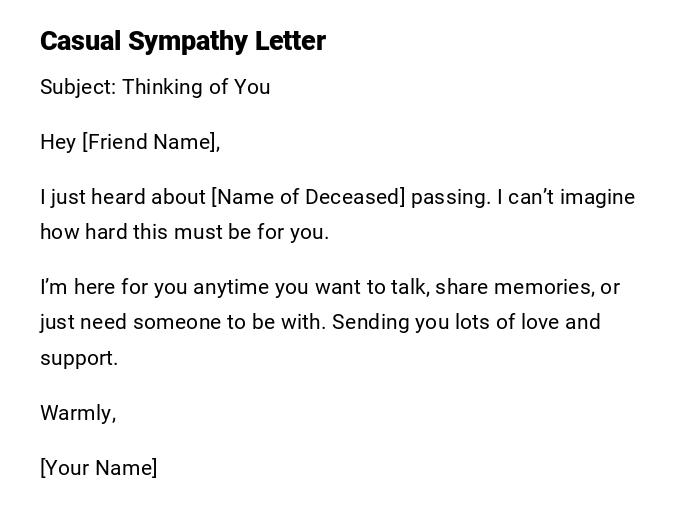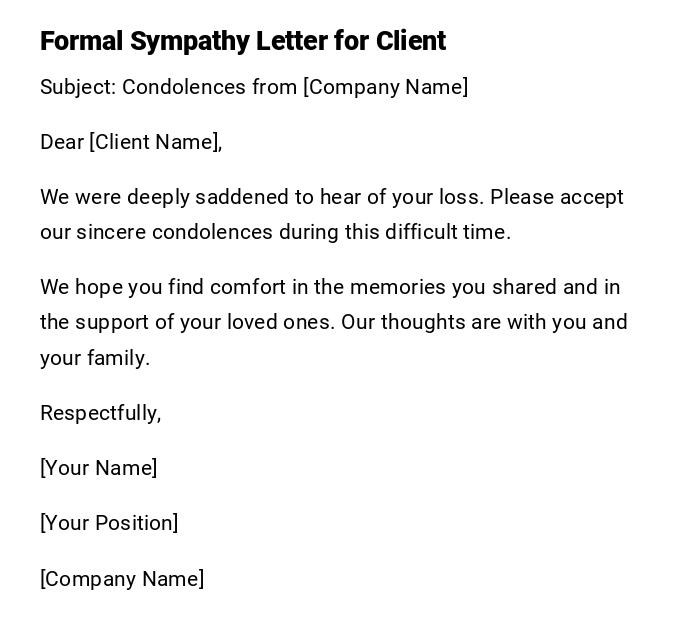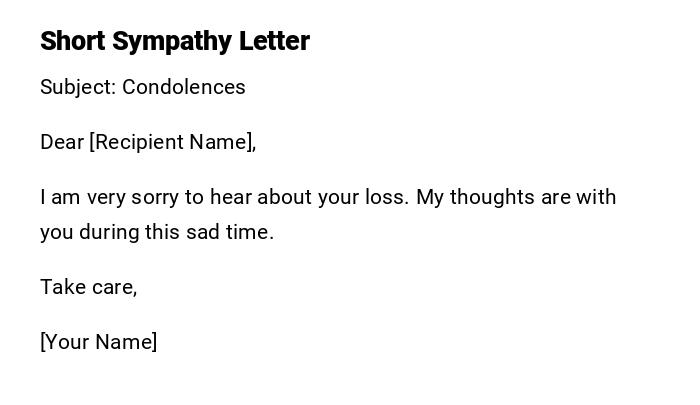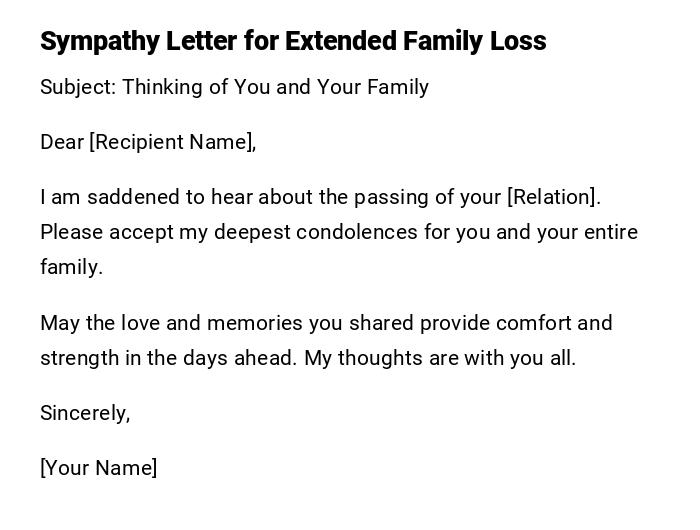Sympathy Letter For Loss
[Your Name]
[Your Address]
[City, State, ZIP Code]
[Email Address]
[Phone Number]
[Date]
[Recipient's Name]
[Recipient's Address]
[City, State, ZIP Code]
Dear [Recipient's Name],
I was deeply saddened to learn about the loss of your [relationship of the deceased], [Name of the deceased]. Please accept my heartfelt sympathies during this difficult time. I understand that no words can ease the pain of losing someone dear, but I hope my letter can offer a small measure of comfort and support.
The loss of a loved one is an incredibly challenging experience, and it's natural to feel overwhelmed with emotions. Grieving is a unique process, and it's essential to give yourself the time and space to heal at your own pace. Remember that you don't have to face this journey alone; your friends and family are here to provide strength and solace whenever you need it.
I want you to know that [Name of the deceased] touched the lives of many people, including mine. They will be remembered for [their kindness, warmth, sense of humor, generosity, etc.], and their presence will be greatly missed. The memories we shared with them will forever hold a special place in our hearts, and their legacy will continue to live on through the lives they've touched.
During these challenging times, it's essential to take care of yourself and those around you. Lean on the support of your loved ones, and don't hesitate to seek professional help if you find the burden too heavy to bear. There's no right or wrong way to grieve, and it's okay to feel a mix of emotions.
Please remember that I am here for you, ready to lend an ear or a helping hand whenever you need it. If you feel comfortable sharing your feelings or reminiscing about the wonderful moments you shared with [Name of the deceased], know that I am willing to listen.
In the coming days and weeks, I hope you find moments of solace in the midst of sorrow and strength in the love and support of those around you. May the cherished memories of [Name of the deceased] bring you comfort and peace as you navigate through this difficult time.
Once again, please accept my deepest condolences. You are in my thoughts and prayers.
With heartfelt sympathy,
[Your Name]
Heartfelt Sympathy Letter for Family Loss
Subject: My Deepest Condolences
Dear [Recipient Name],
I was deeply saddened to hear about the passing of your [Relation, e.g., father/mother]. Please accept my heartfelt condolences during this difficult time.
May you find comfort in the love and support of family and friends, and may the cherished memories of [Name of Deceased] bring you peace.
With sympathy and caring thoughts,
[Your Name]
Professional Sympathy Letter for Colleague
Subject: Condolences on Your Loss
Dear [Colleague Name],
I am saddened to hear about the loss of your [Relation]. On behalf of the team at [Company Name], please accept our deepest sympathies.
Our thoughts are with you and your family, and we hope you find strength and comfort during this challenging time.
Sincerely,
[Your Name]
[Your Position]
Casual Sympathy Letter for Friend
Subject: Thinking of You
Hey [Friend Name],
I just heard about [Name of Deceased] passing. I can’t imagine how hard this must be for you.
I’m here for you anytime you want to talk, share memories, or just need someone to be with. Sending you lots of love and support.
Warmly,
[Your Name]
Formal Sympathy Letter for Client
Subject: Condolences from [Company Name]
Dear [Client Name],
We were deeply saddened to hear of your loss. Please accept our sincere condolences during this difficult time.
We hope you find comfort in the memories you shared and in the support of your loved ones. Our thoughts are with you and your family.
Respectfully,
[Your Name]
[Your Position]
[Company Name]
Sympathy Letter with Support Offer
Subject: Our Deepest Sympathy
Dear [Recipient Name],
I am truly sorry for your loss. During this difficult period, please know that I am here to offer any support you might need, whether it is assistance with daily tasks or simply a listening ear.
May you find comfort in knowing that your friends and loved ones are thinking of you.
With heartfelt sympathy,
[Your Name]
Short and Simple Sympathy Note
Subject: Condolences
Dear [Recipient Name],
I am very sorry to hear about your loss. My thoughts are with you during this sad time.
Take care,
[Your Name]
Heartfelt Sympathy Letter for Extended Family
Subject: Thinking of You and Your Family
Dear [Recipient Name],
I am saddened to hear about the passing of your [Relation]. Please accept my deepest condolences for you and your entire family.
May the love and memories you shared provide comfort and strength in the days ahead. My thoughts are with you all.
Sincerely,
[Your Name]
What / Why a Sympathy Letter is Important
- Expresses care and support for someone experiencing a loss.
- Helps convey condolences and empathy when personal presence is not possible.
- Provides emotional comfort and strengthens relationships in difficult times.
Who Should Send a Sympathy Letter
- Family members and relatives.
- Friends, neighbors, and close acquaintances.
- Colleagues or professional contacts.
- Organizations or community groups offering formal condolences.
Whom Should the Sympathy Letter Be Addressed To
- Immediate family members of the deceased.
- Friends or close associates affected by the loss.
- Professional contacts or clients when offering formal sympathy.
- Extended family or community members if culturally appropriate.
When to Send a Sympathy Letter
- As soon as possible after learning about the death.
- After a funeral or memorial service, if immediate notice wasn’t possible.
- When unable to attend the service personally but still wish to express condolences.
- To mark anniversaries or significant dates related to the deceased.
How to Write and Send a Sympathy Letter
- Start with a respectful greeting and express condolences immediately.
- Mention the name and relationship of the deceased.
- Share a personal memory or kind words about the person.
- Offer support if appropriate, and close with warm regards.
- Send via postal mail for formal letters or email/message for quick digital correspondence.
Requirements and Prerequisites Before Writing
- Confirm the correct spelling of names and relationship.
- Consider cultural and religious sensitivities.
- Decide on tone: formal, casual, heartfelt, or simple.
- Gather any personal anecdotes or memories to include if appropriate.
Formatting Guidelines for Sympathy Letters
- Length: One short page or a brief message.
- Tone: Respectful, sincere, empathetic. Avoid humor or casual language unless suitable for close friends.
- Structure: Greeting, expression of condolences, personal note or memory, offer of support, closing.
- Mode: Physical letter for formal or personal impact; email or message acceptable for quick communication.
After Sending / Follow-up Actions
- Check if the recipient has acknowledged the letter.
- Offer continued support if needed.
- Maintain discretion and sensitivity; avoid pushing for replies or interactions.
Common Mistakes to Avoid in Sympathy Letters
- Being overly long or detailed about your own experiences.
- Using inappropriate humor or casual phrasing.
- Forgetting to address the deceased by name or their relation to the recipient.
- Writing without empathy or consideration for the recipient's feelings.
Elements and Structure of a Sympathy Letter
- Subject line clearly expressing condolences.
- Greeting addressing the recipient appropriately.
- Immediate expression of sympathy.
- Mention of the deceased’s name and relationship.
- Personal memory, anecdote, or comforting words (optional).
- Offer of support if applicable.
- Closing with warmth and sincerity.
- Signature with name and relation/context.
Tricks and Tips for Effective Sympathy Letters
- Keep the message simple and genuine.
- Avoid clichés or overly generic phrases.
- Personalize the letter with shared memories if appropriate.
- Respect cultural and religious norms when expressing condolences.
- Choose handwriting or printed stationery for added personal touch in physical letters.
FAQ About Sympathy Letters
-
Q: Is it acceptable to send a sympathy email?
A: Yes, especially if immediate communication is necessary or physical mail is not feasible. -
Q: How soon should a sympathy letter be sent?
A: Ideally within a week of learning about the loss. -
Q: Can humor be included in a sympathy letter?
A: Only if you are very close to the recipient and it would be comforting; otherwise, avoid. -
Q: Should I mention my own feelings of loss?
A: Keep focus on the recipient’s grief rather than your own experiences.
Compare and Contrast Sympathy Letters With Other Types of Communication
- Unlike casual messages, these letters carry emotional weight and formality when needed.
- Compared to phone calls, letters provide a lasting record of support.
- Alternative to social media messages, offering privacy and personal touch.
- Can be adapted to suit personal, professional, or community-based contexts.









 Download Word Doc
Download Word Doc
 Download PDF
Download PDF